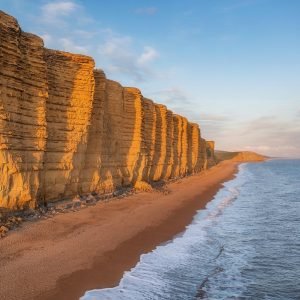UK News
West Bay Beach Shaken as Massive Rock Fall

After a massive rock fall, a section of a beach in Dorset had to be closed off.
East Beach in West Bay, close to Bridport, had a section of its cliff collapse on Tuesday night.
In May, another major collapse occurred along the Jurassic Coast.
A spokesman for Dorset Council stated that the coastguard in West Bay had cordoned off the beach, and that ‘our rangers will inspect the area, make sure there are signs alerting people of the dangers and checking the coast walk’.
Solent Coastguard reportedly informed the authority about the event.
Stay away from the edge and foot of cliffs, and always pay attention to warning signs, safety instructions, and the tides, the spokesman emphasised, adding that while the Jurassic Coast is beautiful, visitors should exercise caution.
Jurassic Coast: Balancing Beauty, Precautions, and Dangers
The Jurassic Coast runs along the southern coast of England and is a geological wonder that is both beautiful and instructive about the planet’s distant past.
West Bay Beach, one of its most famous attractions, attests to the great charm of this World Heritage site. Visitors to this seaside attraction, while surrounded by breathtaking scenery, must bear in mind the inherent safeguards and potential risks of the location.
The Beauty Beyond Compare
West Bay Beach is a breathtaking natural wonder that was shaped by the elements over millions of years, from its golden beaches to its towering cliffs to its crystal clear waters.
The unusual stratified cliffs display a record of almost 185 million years of geological history, telling a chronicle of Earth’s evolution.
The seashore is a photographers and nature lovers dream thanks to its diverse array of colours, shapes, and textures.
Sculpted by Time and Forces
West Bay Beach is unique due to the wide variety of rock types found there. The towering cliffs that surround the beach are made up of sedimentary rock of varying ages, each representing a different chapter in the Earth’s history.
These geological formations provide a window into the changes in the Earth’s environment, climate, and ecosystems over time.
Dazzling Colors and Textures

The cliffs become a kaleidoscope of colours as the light plays across the lake. These rock formations, ranging in colour from dark red to light cream, are a visual representation of the effects of time and nature.
There is a wide variety of textures, from polished and unweathered to rough and sharp. Geological processes have created a masterpiece, and each layer is a brushstroke.
Precautions for a Safe Visit
Visitors should enjoy the stunning scenery of West Bay Beach but do so with care and consideration for the local ecosystem. The very features that make this coastline fascinating also make it hazardous. Here are a few safety measures to take into account:
Safety around Cliffs:
Erosion has rendered the cliffs that frame the beach unsteady. Keep your distance from the cliffs, don’t try to scale them, and never try to dig into or weaken their foundations.
Tide Awareness:
Keep an eye on the tides, as the Jurassic Coast is prone to sudden shifts that can leave stretches of beach inaccessible. If you don’t want to get stuck, it’s important to keep an eye on the time and be aware of rising tides.
Rock Falls:
Unpredictable rock falls have been demonstrated by recent events. Keep to the marked trails and use extreme caution if venturing out onto the rough shoreline.
Weather Considerations:
The British climate is notoriously fickle, so it’s important to plan accordingly. Wear layers, and expect the weather to rapidly shift from sunny to windy to rainy.
Durdle Door Connection
West Bay is a portion of the Jurassic Coastline and is famous for its cliffs and beach. Another famous natural limestone arch, Durdle Door, is easily accessible from West Bay.
FAQs
Where can you find a beach known as the Jurassic Coast?
The Jurassic Coast is a section of the English Channel shoreline in the south of the country. Exmouth in Devon to Studland Bay in Dorset is roughly the length of its 95-mile (153-kilometer) length.
The Jurassic Coast is a stretch of England’s southern coast known for its breathtaking cliffs, beaches, and geological formations that display fossils and rock layers from the Jurassic, Triassic, and Cretaceous periods of Earth’s history.
Are there fossils in West Bay beach?
West Bay Beach on Dorset’s Jurassic Coast has fossils. The Jurassic, Triassic, and Cretaceous fossils in these cliffs and rocks attract fossil hunters and aficionados.
Ammonites, belemnites, crinoids, bivalves, and even ichthyosaurs and plesiosaurs are found in West Bay. These fossils reveal millions-year-old sea habitats and its inhabitants.
Responsible fossil hunting should follow local laws. Guided fossil hunting excursions may teach you how to hunt safely and responsibly. Always observe rules to protect the environment and fossils.
Are there dinosaurs in the Jurassic Coast?
The Jurassic Coast is famous for its Jurassic, Triassic, and Cretaceous fossils, although “dinosaurs” refers to Mesozoic terrestrial reptiles. The Jurassic Coast’s fossils include ammonites, belemnites, ichthyosaurs, plesiosaurs, and other marine life.
Dinosaurs lived on land, hence their fossils are found inland rather than on the coast. However, the Jurassic Coast does reveal old ecosystems and environments, including the dinosaur world.
The Jurassic Coast’s geological characteristics and fossil record help us comprehend prehistoric life, including dinosaurs. If you’re interested in dinosaur fossils, you might like to see additional terrestrial fossil sites throughout the world.











